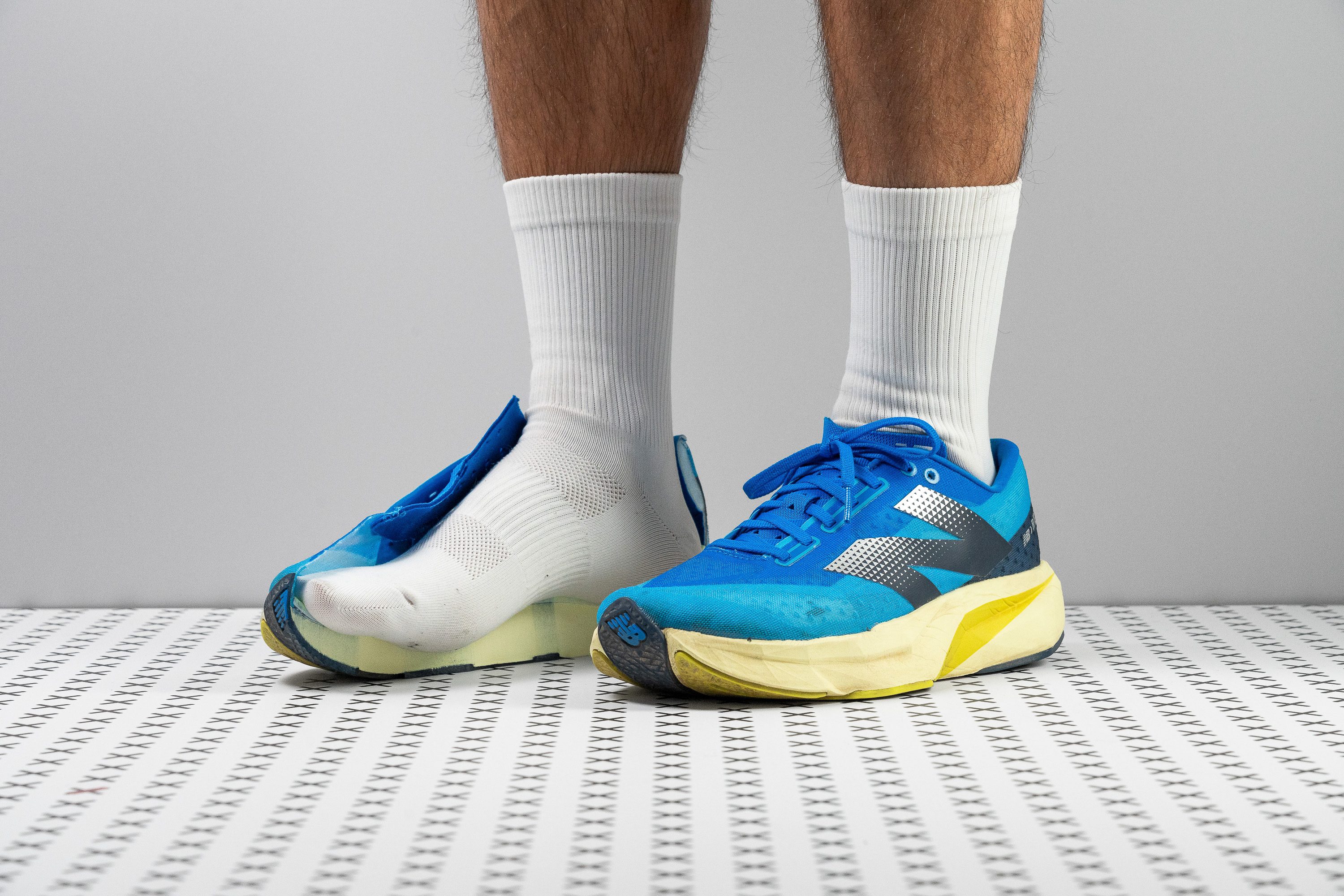Our verdict
- Top pick in best cushioned New Balance running shoes (2024)
Pros
- Natural, flexible ride
- Enhanced energy return!
- Remains a fun ride
- Finally accommodates wide feet
- Reasonably priced at $140
- Ample traction
- Fantastic stability
- Plush and comfy midsole
Cons
- Heel lock needs improvement
- Now it's even... too wide!
Audience verdict
- Top 9% most popular running shoes
Comparison
The most similar running shoes compared
+ + Add a shoe | |||||
|---|---|---|---|---|---|
| Audience score | 86 Good! | 91 Superb! | 70 Bad! | 87 Great! | |
| Price | $140 | $140 | $70 | $110 | |
| Pace | Daily runningTempo | Daily runningTempo | Daily running | Daily running | |
| Shock absorption | High | High | Low | - | |
| Energy return | Moderate | Moderate | Moderate | - | |
| Traction | High | High | Moderate | - | |
| Arch support | Neutral | Neutral | Neutral | Neutral | |
| Weight lab Weight brand | 7.5 oz / 213g 7.7 oz / 218g | 7.8 oz / 220g 7.9 oz / 225g | 8.5 oz / 242g 8.7 oz / 246g | 9 oz / 254g 9.4 oz / 266g | |
| Lightweight | ✓ | ✓ | ✓ | ✗ | |
| Drop lab Drop brand | 6.5 mm 6.0 mm | 6.3 mm 6.0 mm | 7.7 mm 8.0 mm | 6.0 mm 8.0 mm | |
| Strike pattern | Mid/forefoot | Mid/forefoot | Mid/forefoot | Mid/forefoot | |
| Size | Slightly small | True to size | True to size | True to size | |
| Midsole softness | Soft | Soft | Soft | Balanced | |
| Difference in midsole softness in cold | Big | Small | Big | Small | |
| Toebox durability | Bad | Bad | Bad | Bad | |
| Heel padding durability | Good | Good | Bad | Decent | |
| Outsole durability | Good | Good | Good | Good | |
| Breathability | Moderate | Moderate | Moderate | Warm | |
| Width / fit | Medium | Medium | Medium | Medium | |
| Toebox width | Wide | Medium | Medium | Medium | |
| Stiffness | Flexible | Moderate | Flexible | Stiff | |
| Torsional rigidity | Flexible | Flexible | Flexible | Flexible | |
| Heel counter stiffness | Flexible | Moderate | Flexible | Flexible | |
| Rocker | ✓ | ✓ | ✗ | ✗ | |
| Heel lab Heel brand | 28.0 mm 30.0 mm | 33.0 mm 35.0 mm | 28.1 mm | 30.2 mm 27.0 mm | |
| Forefoot lab Forefoot brand | 21.5 mm 24.0 mm | 26.7 mm 29.0 mm | 20.4 mm | 24.2 mm 19.0 mm | |
| Widths available | NormalWide | NormalWide | NarrowNormalWideX-Wide | Normal | |
| Orthotic friendly | ✓ | ✓ | ✓ | ✓ | |
| Season | All seasons | All seasons | All seasons | All seasons | |
| Removable insole | ✓ | ✓ | ✓ | ✓ | |
| Ranking | #395 Bottom 40% | #32 Top 9% | #368 Bottom 1% | #166 Top 45% | |
| Popularity | #57 Top 9% | #34 Top 10% | #17 Top 5% | #310 Bottom 17% |
Who should buy
We believe the New Balance FuelCell Rebel v4 is a fantastic choice for:
- Those who loved the previous Rebels and desired a roomier upper, as we believe they will find this version to be a perfect fit.
- Runners looking for a lightweight, stable, and fun shoe that delivers on all fronts while still being priced at just $140.
- Individuals who need a shoe for daily runs and speed workouts but prefer to avoid stiffer models with a plate.
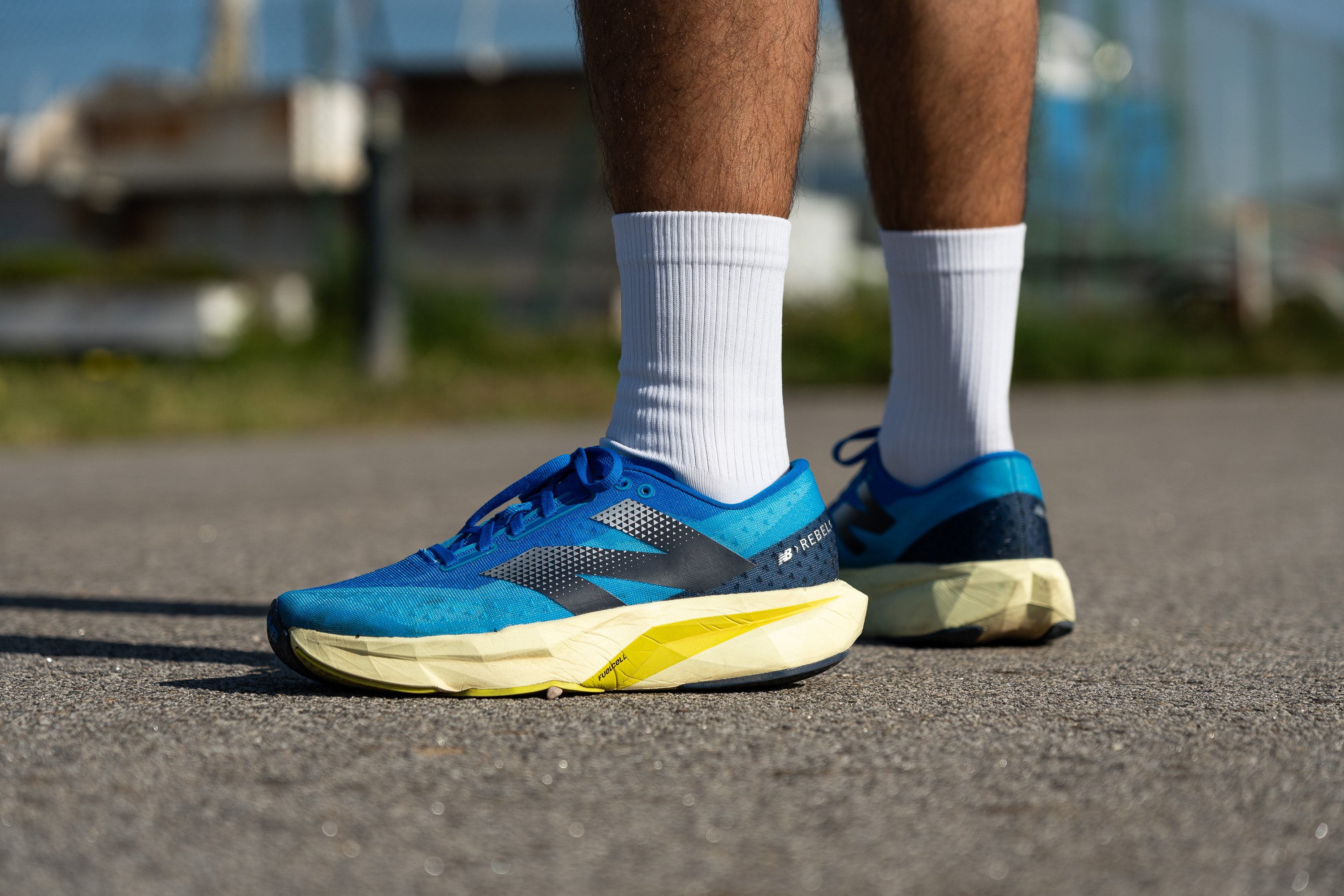
Who should NOT buy
The New Balance FuelCell Rebel v4 might not satisfy those who prefer maximalist running shoes due to its sub-30-mm stack height.
We believe there are better choices for runners seeking more cushioning at a similar price and weight. The ASICS Novablast 5 offers a thicker platform, making it a more suitable alternative. Additionally, if budget isn't a constraint and you desire even more cushioning, we recommend checking out the ASICS Superblast 2.
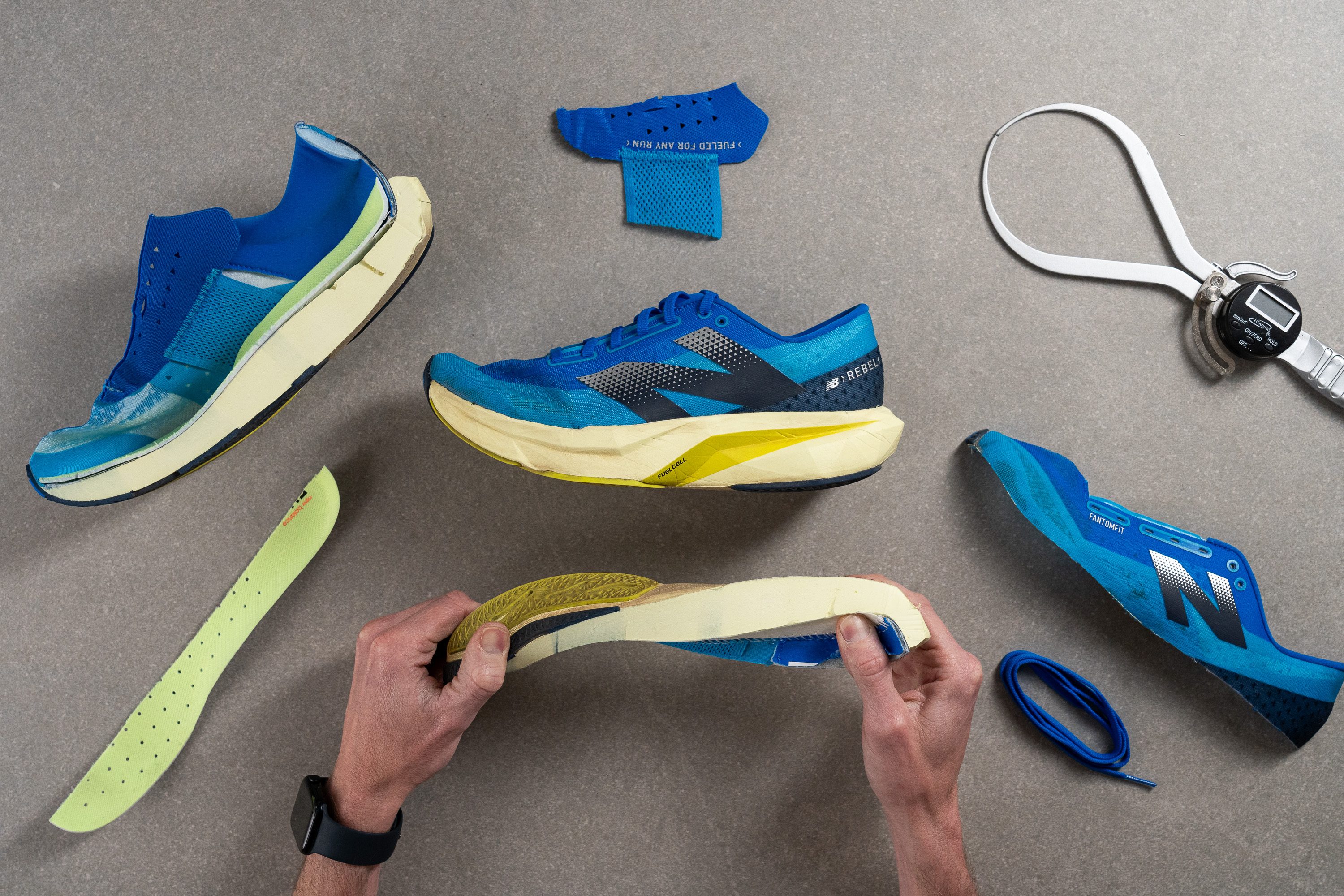
We also think that the Rebel v4 is not the best option for runners with narrow feet. Our lab tests have shown it's quite wide, which may lead to a less secure fit. We do not recommend this shoe for such runners—instead, the NB Rebel v3 or the Hoka Mach 5 would provide better lockdown and overall fit.
Cushioning
Shock absorption
We found that the Rebel v4 delivers outstanding shock absorption in the heel at 139 SA—a clear sign of the technological leap this model has made. That’s thanks to New Balance now blending 20% PEBA into the FuelCell foam.
On the flip side, the forefoot measures just 97 SA due to the midsole’s design.

| FuelCell Rebel v4 | 139 SA |
| Average | 129 SA |
Energy return
Adding PEBA not only enhances shock absorption, but more importantly, brings a noticeable boost in energy return. The Rebel v4 now ranks among the most exciting daily trainers out there, with 63.1% in the heel and 66.8% in the forefoot. No wonder it felt so bouncy!
| FuelCell Rebel v4 | 63.1% |
| Average | 58.5% |
Heel stack
The heel height of just 28.0 mm is notably lower than most running shoes, especially recent launches. However, the Rebel has always favored a moderately low design, and 28.0 mm is well-suited for its purpose—not for long runs, but for fast and fun ones.
It’s also worth mentioning that the midfoot is slightly thicker than 28.0 mm. However, we measure every shoe according to World Athletics guidelines, regardless of its geometry.
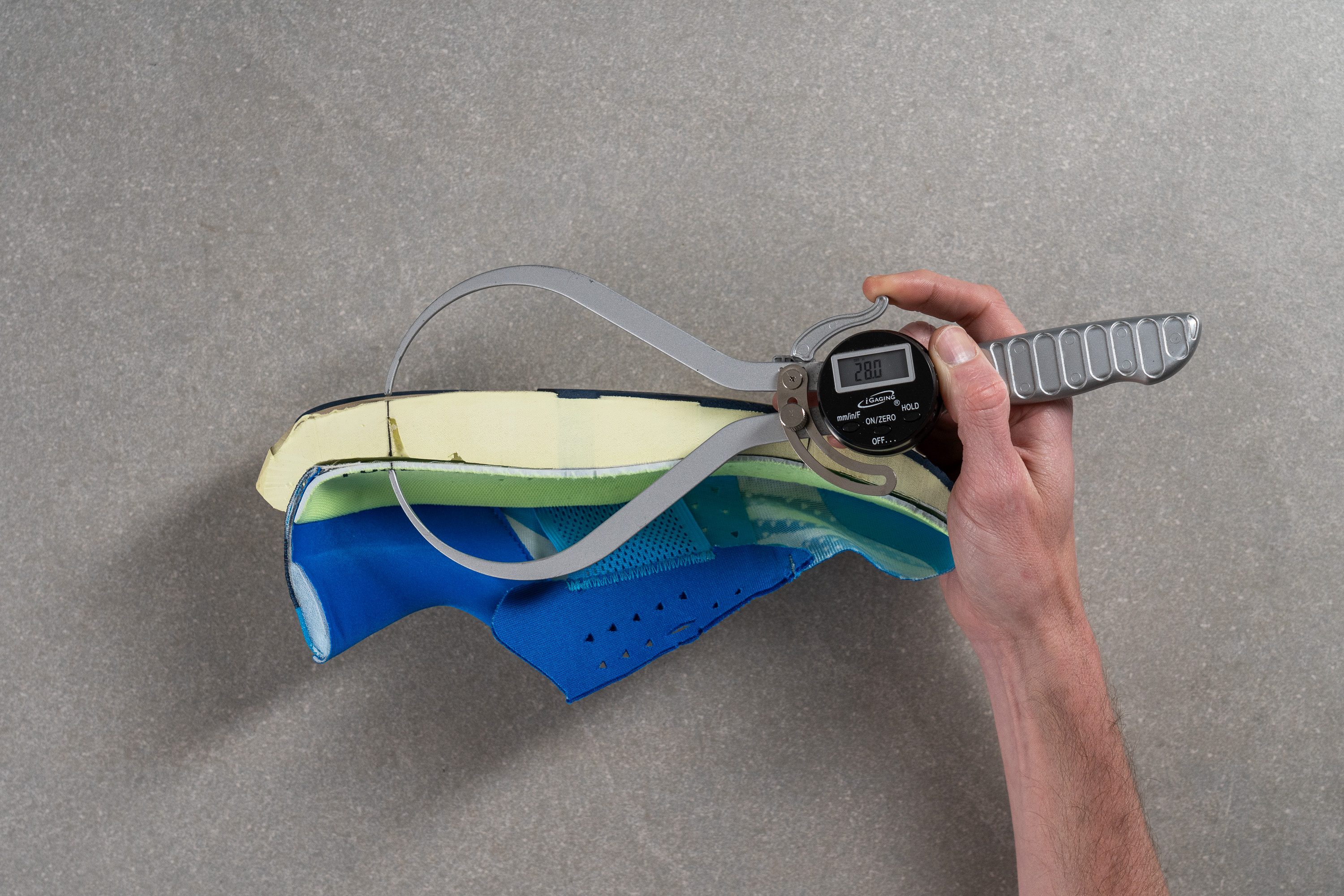
| FuelCell Rebel v4 | 28.0 mm |
| Average | 34.8 mm |
Forefoot stack
Measured in our lab and still following World Athletics guidelines, the forefoot came in at just 21.5 mm.
This dimension is a blessing for those who prefer a natural ride with plenty of ground feel. However, we believe it may not fully satisfy those who favor more cushioned, maximalist shoes.

| FuelCell Rebel v4 | 21.5 mm |
| Average | 26.2 mm |
Drop
The Rebel v4 adopts the design and geometry similar to its racing counterpart, the Elite v4, which we've noted that causes the midfoot to be higher than the heel. This design may not be ideal for heel strikers, who could sink into the rear of the Rebel.
We also measured a 6.5-mm drop, which is particularly suitable for runners who utilize a midfoot or forefoot striking technique.

| FuelCell Rebel v4 | 6.5 mm |
| Average | 8.6 mm |
Midsole softness
And speaking of the midsole, it still bears the FuelCell name, yet the foam has evolved significantly from the previous Rebels. Now, it's composed of 20% PEBA and 80% EVA—an improvement from its predecessor, although it still doesn’t match the premium, pure-PEBA FuelCell found in the Elite v4.
This iteration of FuelCell remains pillowy-soft—like every Rebel—at just 8.5 HA, but feels just a bit firmer underfoot than previous versions because of the inclusion of PEBA. We found this advantageous for heavier runners as it really helps to prevent bottoming out.
Finally, we have to admit that having crafted a massive guide on midsole foams, we find it frustrating when companies use the same name for midsoles that are totally different.
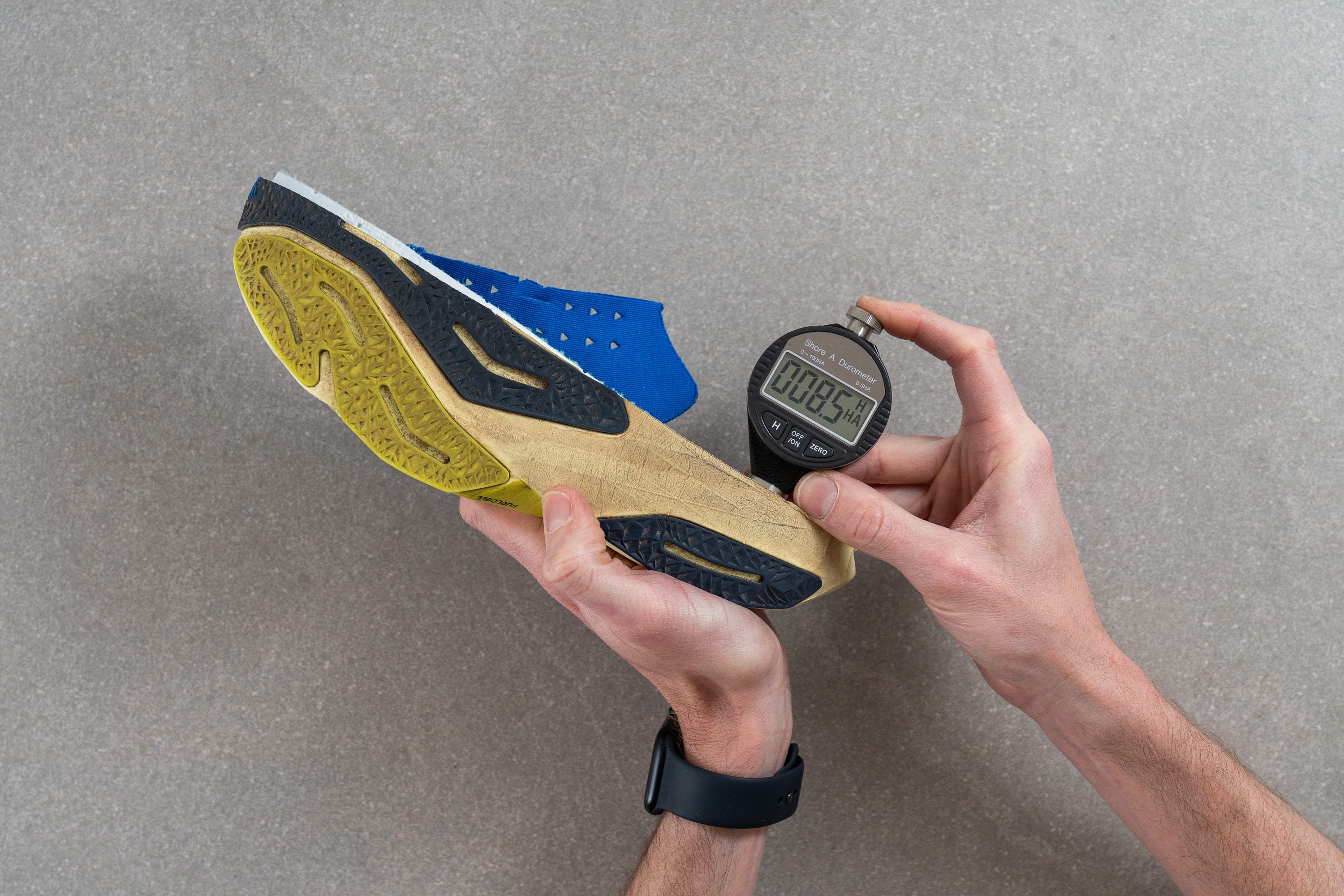
| FuelCell Rebel v4 | 8.5 HA |
| Average | 20.4 HA |
Rocker
Another significant change from the earlier versions of the Rebel is the introduction of a rocker. It now sports a distinct curved shape in both the heel and forefoot—a shift that moves away from the flatter design of its predecessors.
While this rocker certainly helps promote forward motion and smoother transitions, we feel that runners who enjoyed the racing-flat vibes of the previous models might not appreciate this new feature.
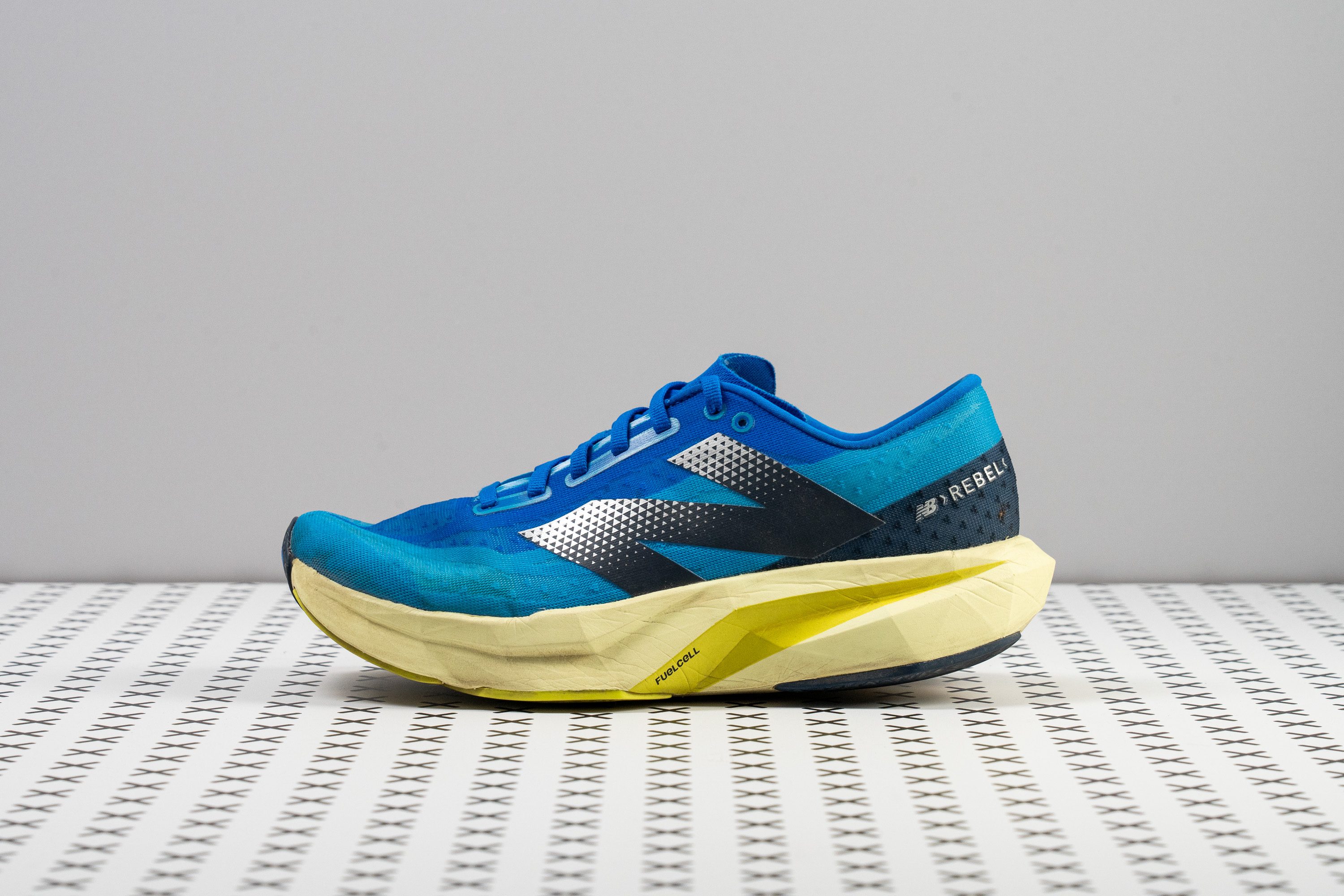
Size and fit
Size
New Balance FuelCell Rebel v4 fits slightly small (340 votes).
Width / Fit
Regarding fit, while the previous Rebels had their fans, they also faced criticism for being too snug. In our view, New Balance addressed this feedback by designing a shoe that felt significantly roomier from our first run.
Back in the lab, we tested this by creating a gel mold of the Rebel v4's interiors for precise measurements. The first reading was 96.0 mm—noticeably wider than earlier versions but still relatively average.

| FuelCell Rebel v4 | 96.0 mm |
| Average | 95.1 mm |
Toebox width
The big toe area has seen the most dramatic transformation—it’s where the magic truly happens with this shoe. Earlier Rebel models were known for their tapered toeboxes, but this redesign marks a complete shift.

After testing, we discovered a 78.4-mm measurement using our calipers, highlighting the change. Additionally, it’s worth noting that New Balance offers this model in 2E width, yet only in select markets.

| FuelCell Rebel v4 | 78.4 mm |
| Average | 73.2 mm |
Toebox height
In terms of height, the room feels adequate. Indeed, based on our findings, the 27.3 mm measurement should suffice for most runners. However, don’t expect ultra-generous space for vertical toe movement given the non-stretch material of the upper.
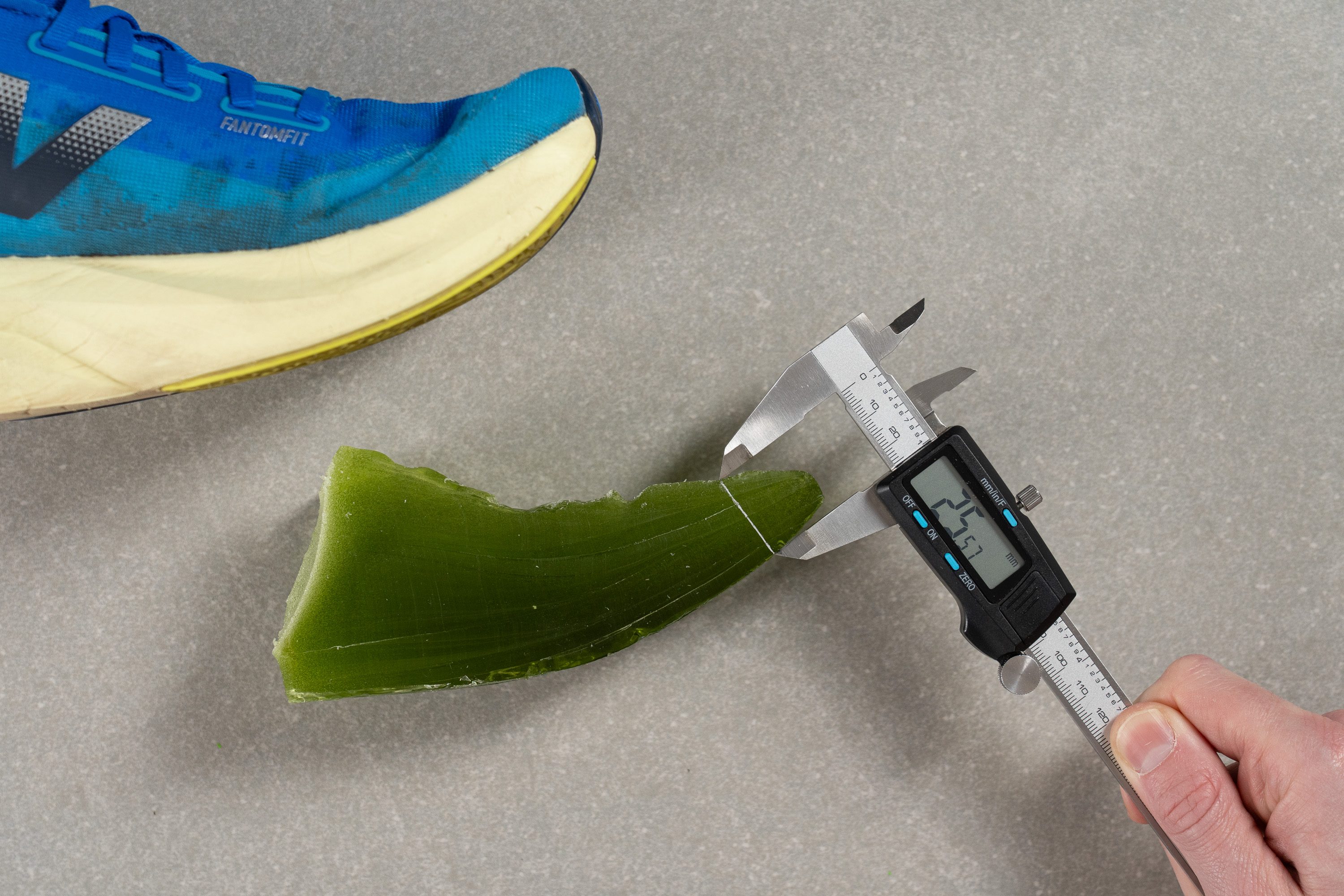
| FuelCell Rebel v4 | 27.3 mm |
| Average | 27.1 mm |
Traction / Grip
Traction test
There is a lot of exposed foam at the bottom of the Rebel v4 but it's got good rubber coverage in the forefoot. And that's what matters the most if you want to avoid slipping and skidding during the run.
Our SATRA TM144 grip test returned a solid friction score of 0.50 which confirms the shoe's sufficient grip on both dry and wet concrete.
| FuelCell Rebel v4 | 0.50 |
| Average | 0.48 |
Outsole design
The outsole of the Rebel v4 has been significantly upgraded from its predecessor, now sporting a completely new rubber pattern designed to enhance both grip and durability.
We appreciated the rubber and the lengthy central strip on the outsole but found that the coverage in the heel area might be a bit too sparse for rearfoot strikers.
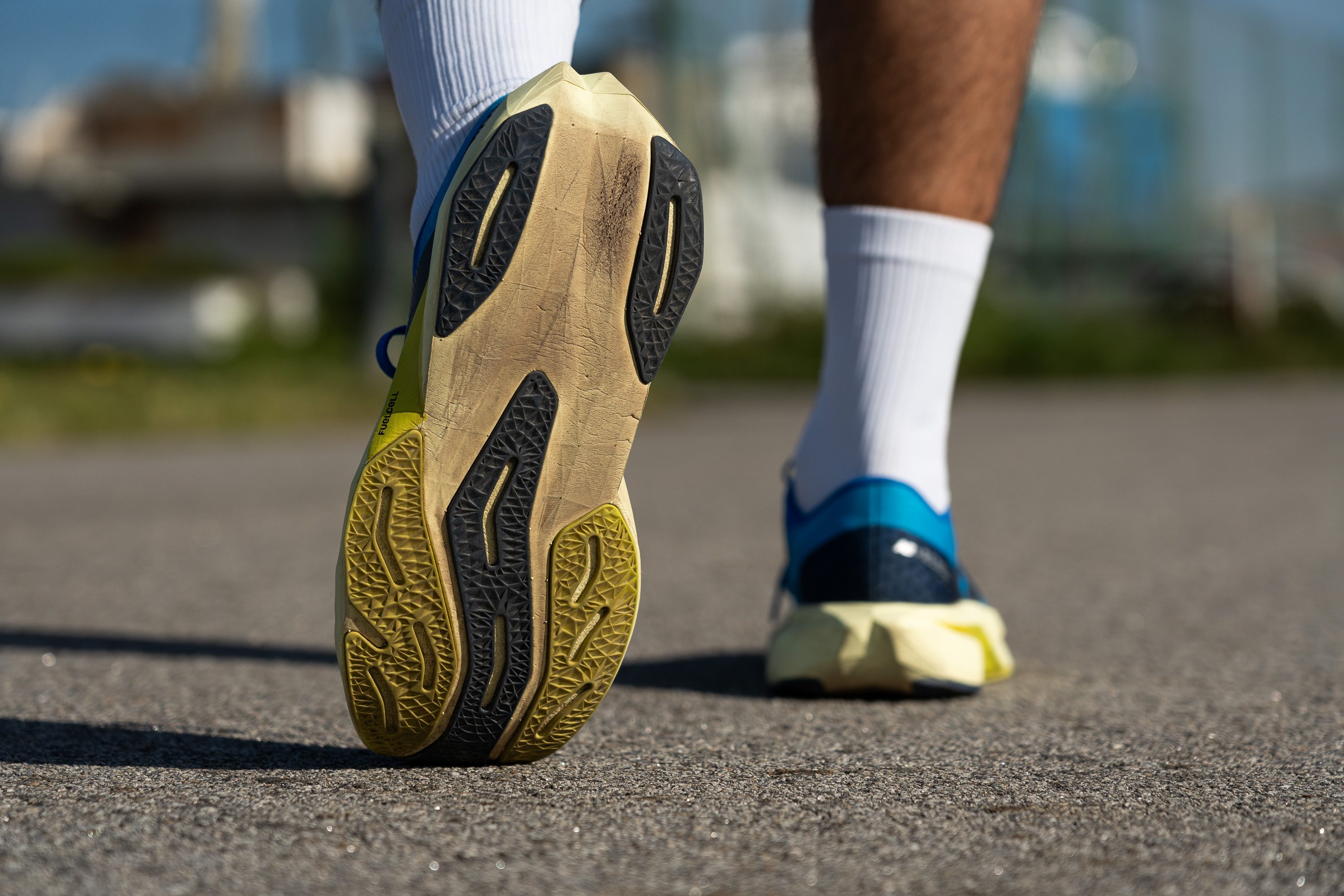
Flexibility / Stiffness
Another hallmark of the Rebel series has always been its exceptionally low stiffness, making it a top choice for those who prefer a natural-feeling, flexible running shoe that lets the feet work without the aid of Pebax or carbon-fiber plates.
Fortunately, our 30-degree bend test showed it to be more flexible than nearly every other shoe on the market, requiring just 8.1N to bend.
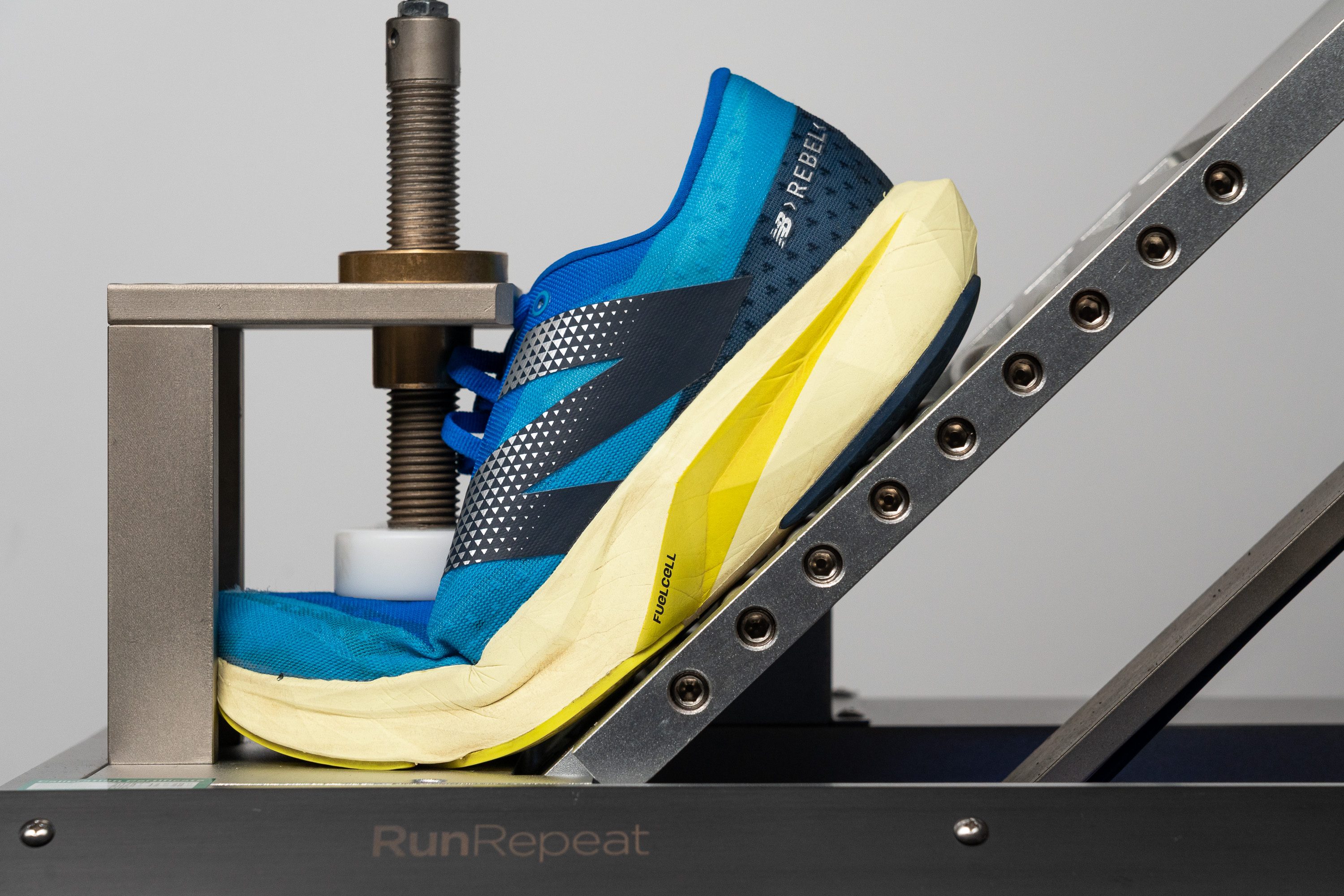
| FuelCell Rebel v4 | 8.1N |
| Average | 15.3N |
Weight
One of the standout features of the Rebel series has always been its lightweight design, and despite appearing like a supercharged version of previous models, New Balance has impressively managed to keep the shoe under 8 ounces.
In fact, it weighs just 7.5 oz or 213g—truly remarkable.
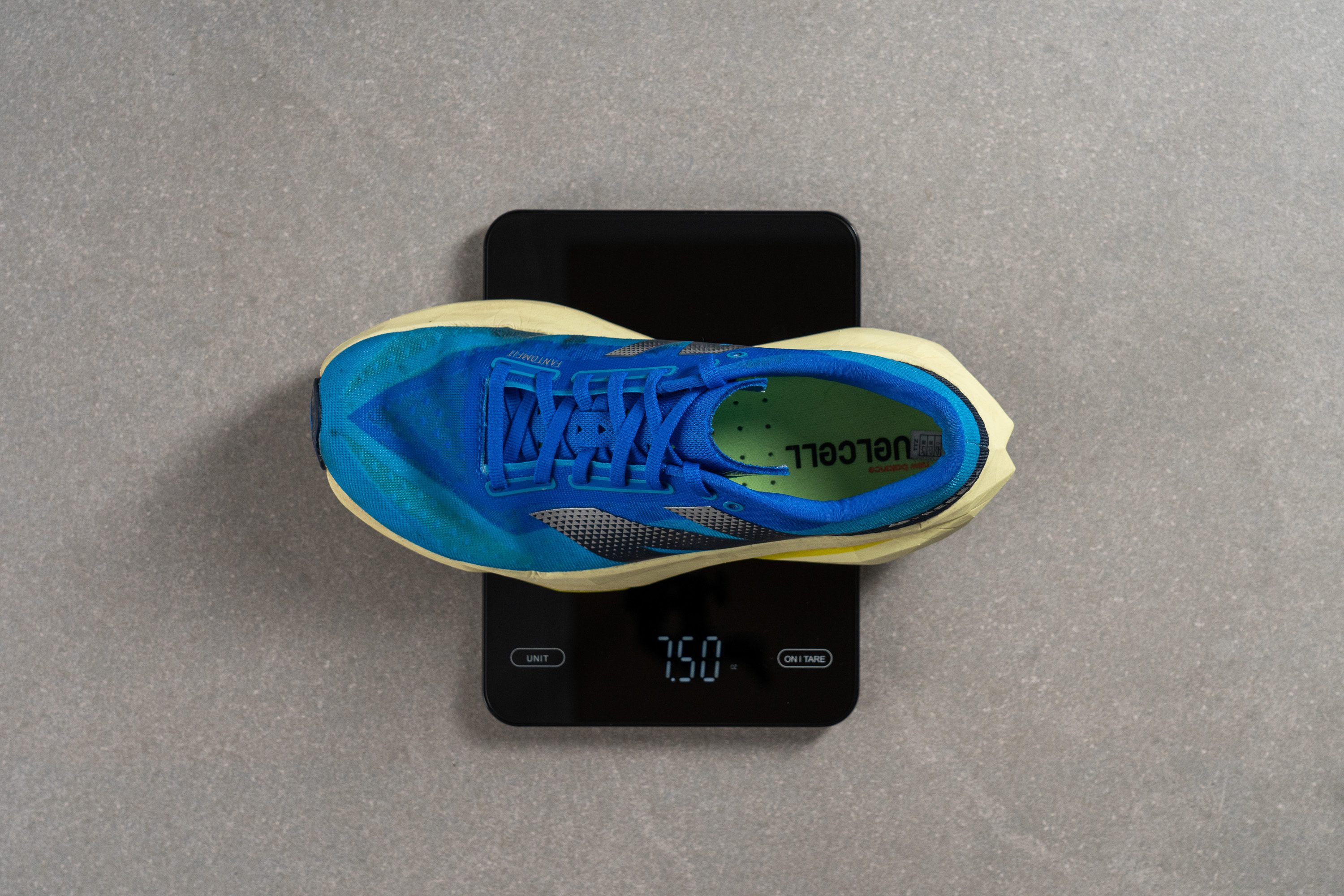
| FuelCell Rebel v4 | 7.5 oz (213g) |
| Average | 9.3 oz (264g) |
Breathability
The Rebel v4's upper has undergone a significant transformation from its predecessors. It still features engineered mesh, but New Balance has reintroduced an older technology called FantomFit, which combines excellent ventilation with structured support.
Next, we examined the upper under a light, which revealed the shoe's construction details. The toebox starts off super-thin, and then the shoe adds more layers to enhance stability, although this slightly reduces airflow in those areas.
Using the light, we also discovered that the upper differs significantly from most engineered mesh designs. Rather than being thicker with some ventilation holes, it's exceptionally thin but includes thicker areas strategically placed throughout.
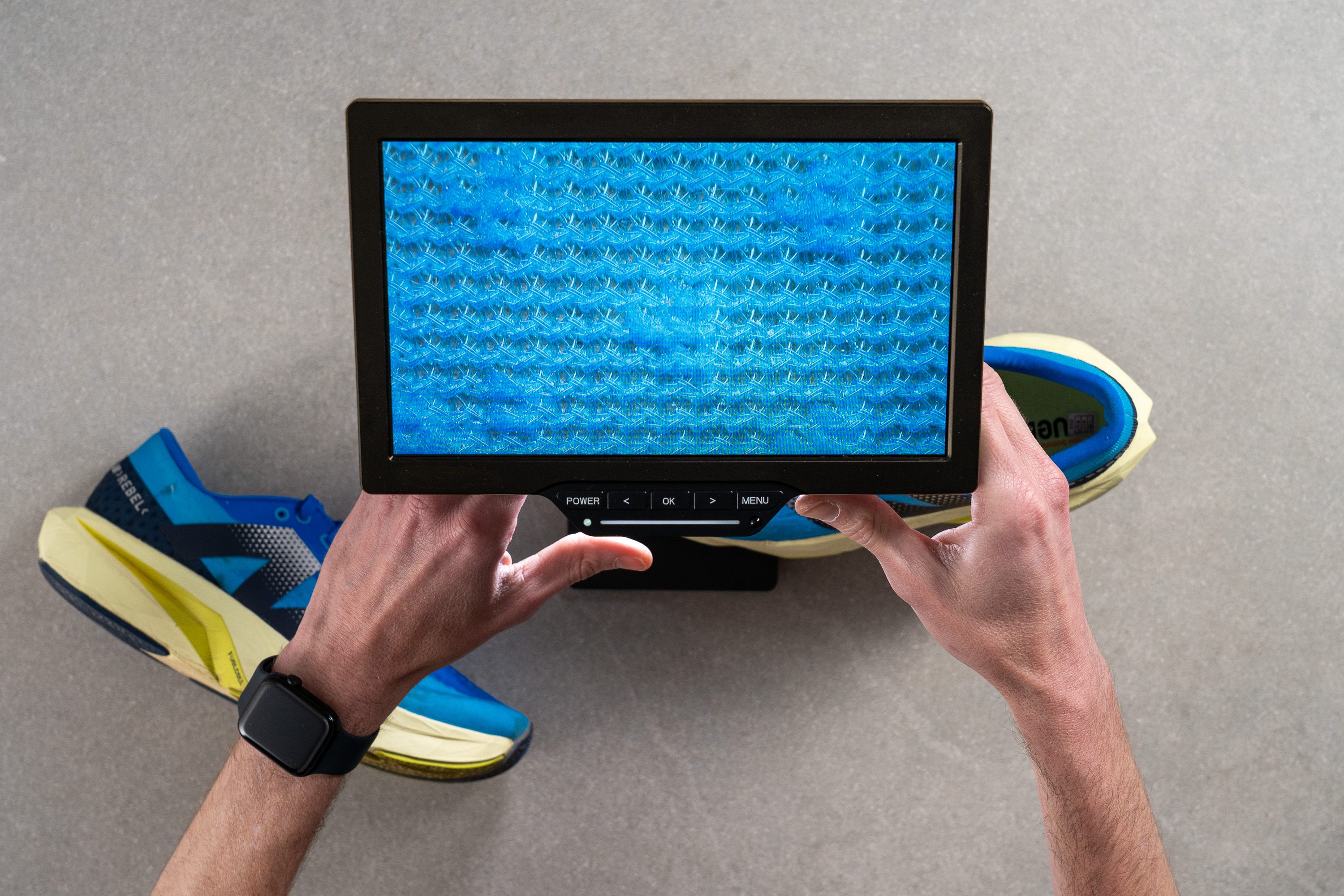
To further analyze these thicker areas, we switched to the microscope.

It's fascinating that New Balance opted for a completely opposite approach than most running shoes on the market. We always appreciate when brands try different stuff!
The upper is minimally padded, prioritizing lightness above all else—except in the heel area. But, as always, the Rebel is designed for a lightweight experience—take it or leave it.
| FuelCell Rebel v4 | 4 |
| Average | 3.7 |
Stability
Lateral stability test
One of the most significant changes—aside from aesthetics—in the latest Rebel is its stability. Previously, the Rebel series was known for being somewhat unstable, but this latest version has completely flipped the script with multiple changes like massive midsole sidewalls.
In our view, this substantial shift in design won't be for everyone. Sure, increased stability might sound great, but it does take away from the fun, wild ride that characterized previous Rebels. That less practical, yet fascinatingly unique aspect was a big part of their charm. After all, having fun is a big reason of why we run, isn't it?
Torsional rigidity
A major factor in the domesticated ride of the Rebel v4 is its torsional rigidity. Although still relatively low at 2/5, this marks an increase from the super-flexible Rebel v3, which scored 1/5 and offered an exceptionally natural ride.
| FuelCell Rebel v4 | 2 |
| Average | 3.5 |
Heel counter stiffness
We discovered another unexpected change— the heel counter is less stiff than before, now rated at 2/5 compared to the previous 3/5.
This is somewhat concerning to us, as the heel isn't very padded, and the lockdown isn't as effective as it used to be. However, employing a runner's knot could potentially resolve any issues.
| FuelCell Rebel v4 | 2 |
| Average | 2.9 |
Midsole width - forefoot
Yet, it's in the midsole width where this shoe has undergone its most significant change. Moving from 110.3 mm in the Rebel v3, our lab measurements show the updated version at an impressive 124.7 mm—a massive adjustment with crucial implications.
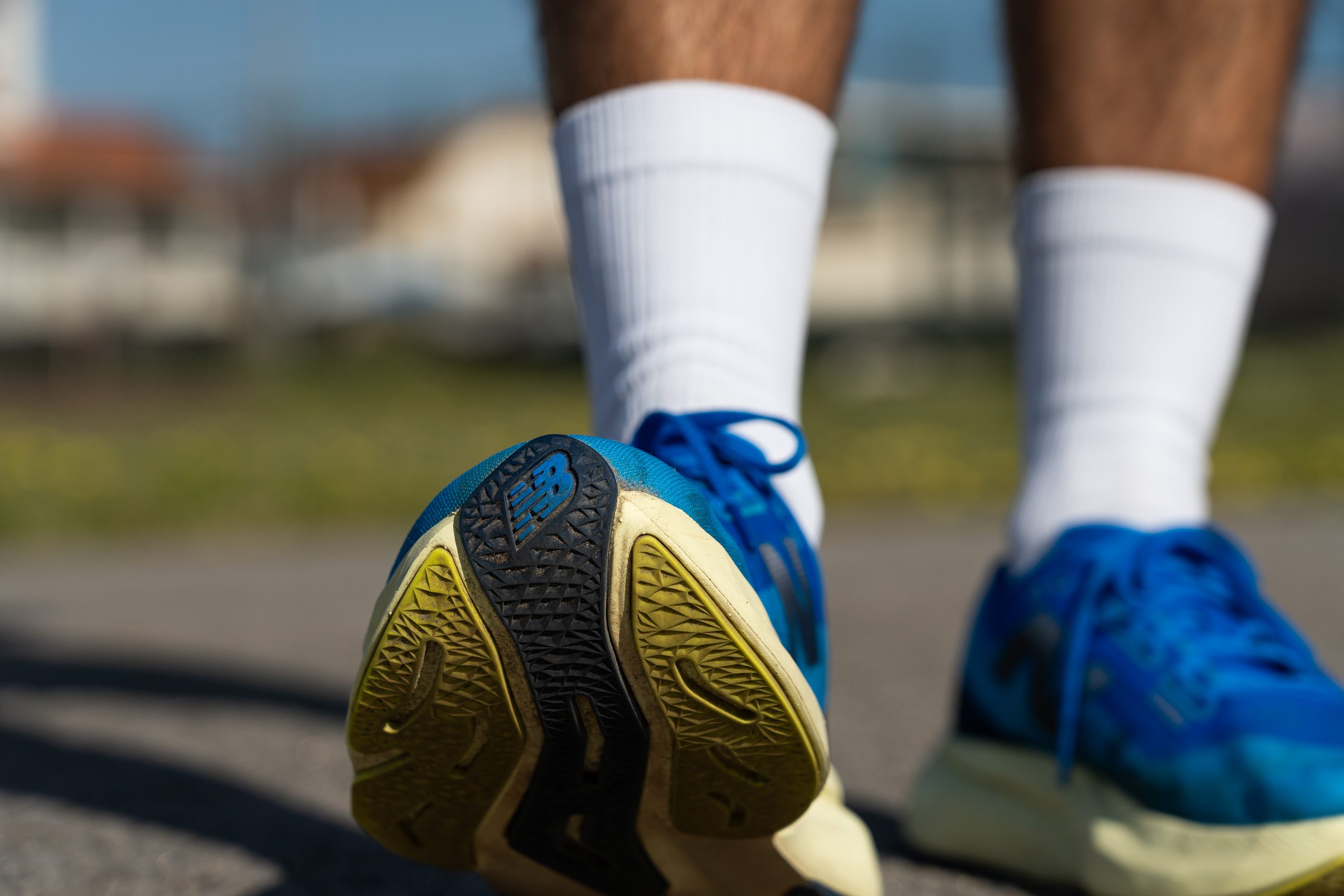
The most noticeable impact, as previously mentioned in this lab review, is the increased stability provided by the now gargantuan landing platform, similar to some stability shoes. The major downside? Agility and fun suffer, as the shoe doesn't move as nimbly as before.
Think of it this way—if the Rebel v3 was like a go-kart, the Rebel v4 is akin to a lightweight sports hatchback.
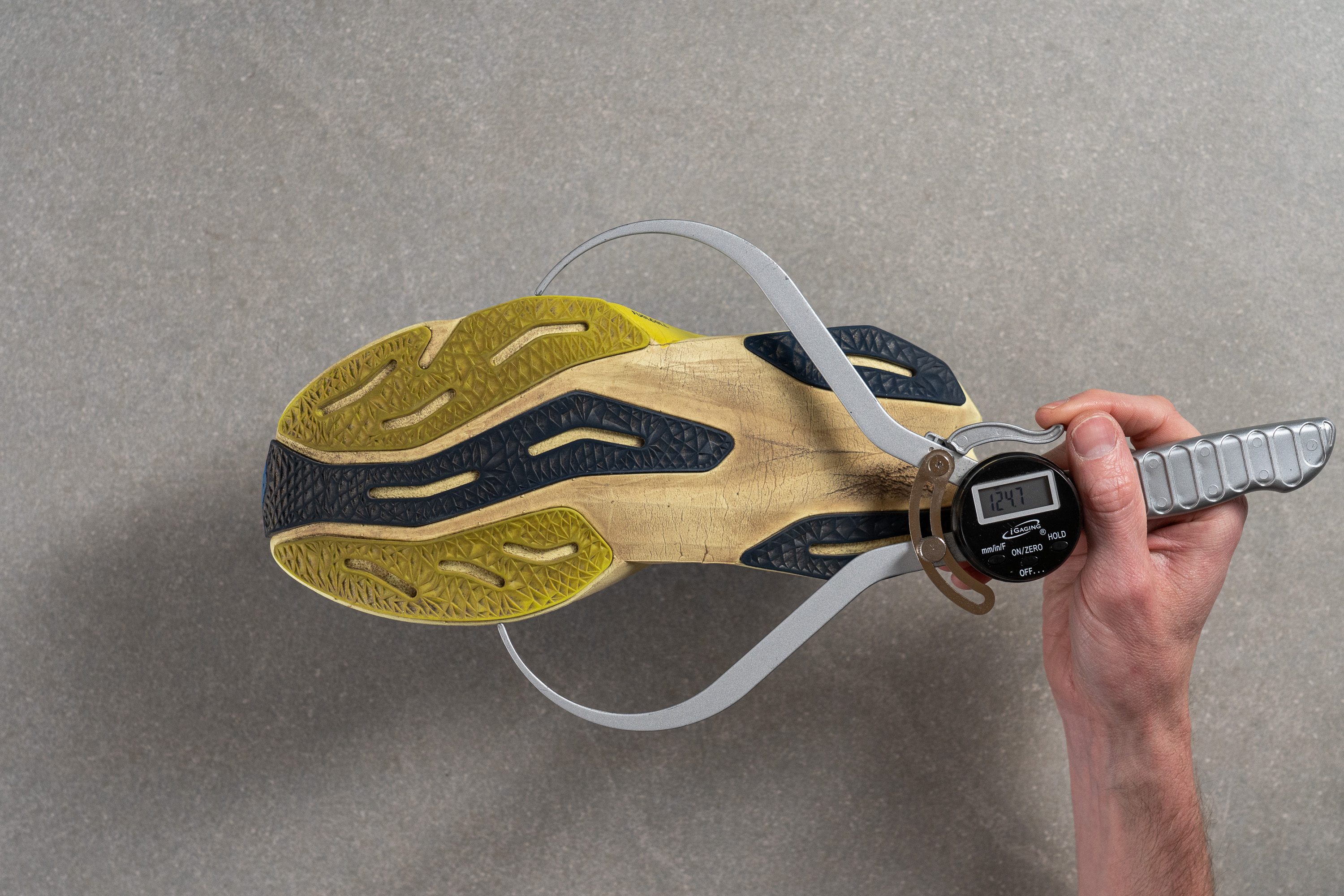
| FuelCell Rebel v4 | 124.7 mm |
| Average | 114.4 mm |
Midsole width - heel
The heel provided an even bigger surprise than the forefoot, prompting us to double-check our measurements due to the dramatic change between generations.
The Rebel v4 features a 101.5-mm heel, a substantial increase from the 81.5-mm heel of the Rebel v3, making it 25% wider than before!

| FuelCell Rebel v4 | 101.5 mm |
| Average | 90.7 mm |
Durability
Toebox durability
The FantomFit upper delivers a lightweight and breathable experience, yet durability tells a completely different story.
We tested the upper with our Dremel tool—like we do with all our shoes—and unfortunately, we discovered one of the worst durability results we've seen in the lab. This clearly earns a 1/5 rating.
It's evident that it won't be a super durable shoe for those prone to wearing holes. For anyone in that category, we recommend opting for a more robust option like the Endorphin Speed 4.
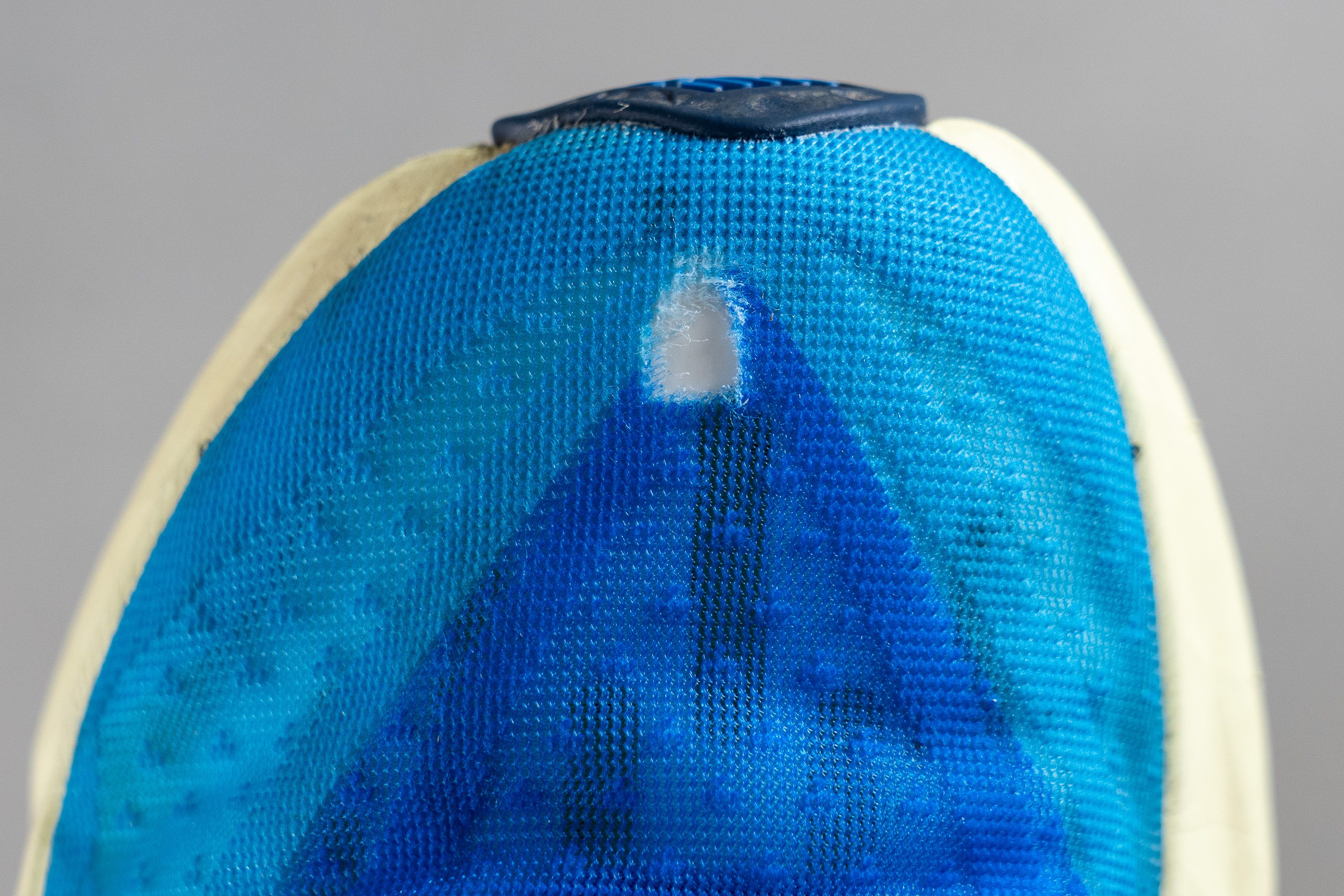
| FuelCell Rebel v4 | 1 |
| Average | 2.6 |
Heel padding durability
After applying the Dremel for the second time, we were thrilled to discover an outstanding outcome—the complete opposite of the previous one.
It was so impressive that we awarded it a perfect 5/5!
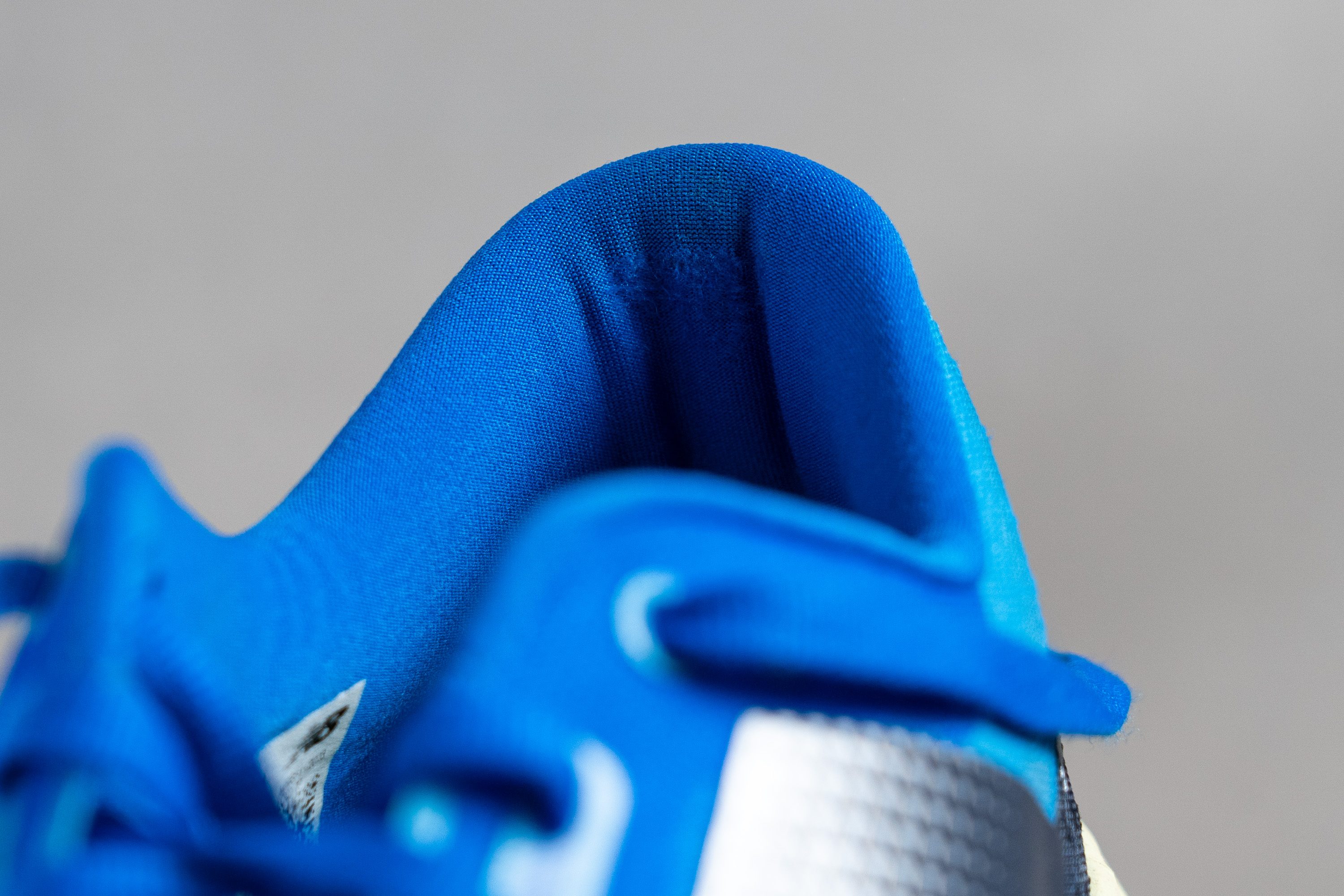
| FuelCell Rebel v4 | 5 |
| Average | 3.4 |
Outsole durability
In our latest Dremel test, we adjusted our approach due to the tougher nature of the rubber compared to the upper. We increased the speed to 10K RPM and ran the tool for a longer period.
The results were satisfactory, though not astonishing, as we found a 0.8-mm indentation in the rubber.

| FuelCell Rebel v4 | 0.8 mm |
| Average | 1.1 mm |
Outsole thickness
In our final analysis of the outsole, we measured a thickness of 3.2 mm. While this might appear average compared to other shoes, it's actually quite generous from New Balance for a shoe designed to be as lightweight as possible.
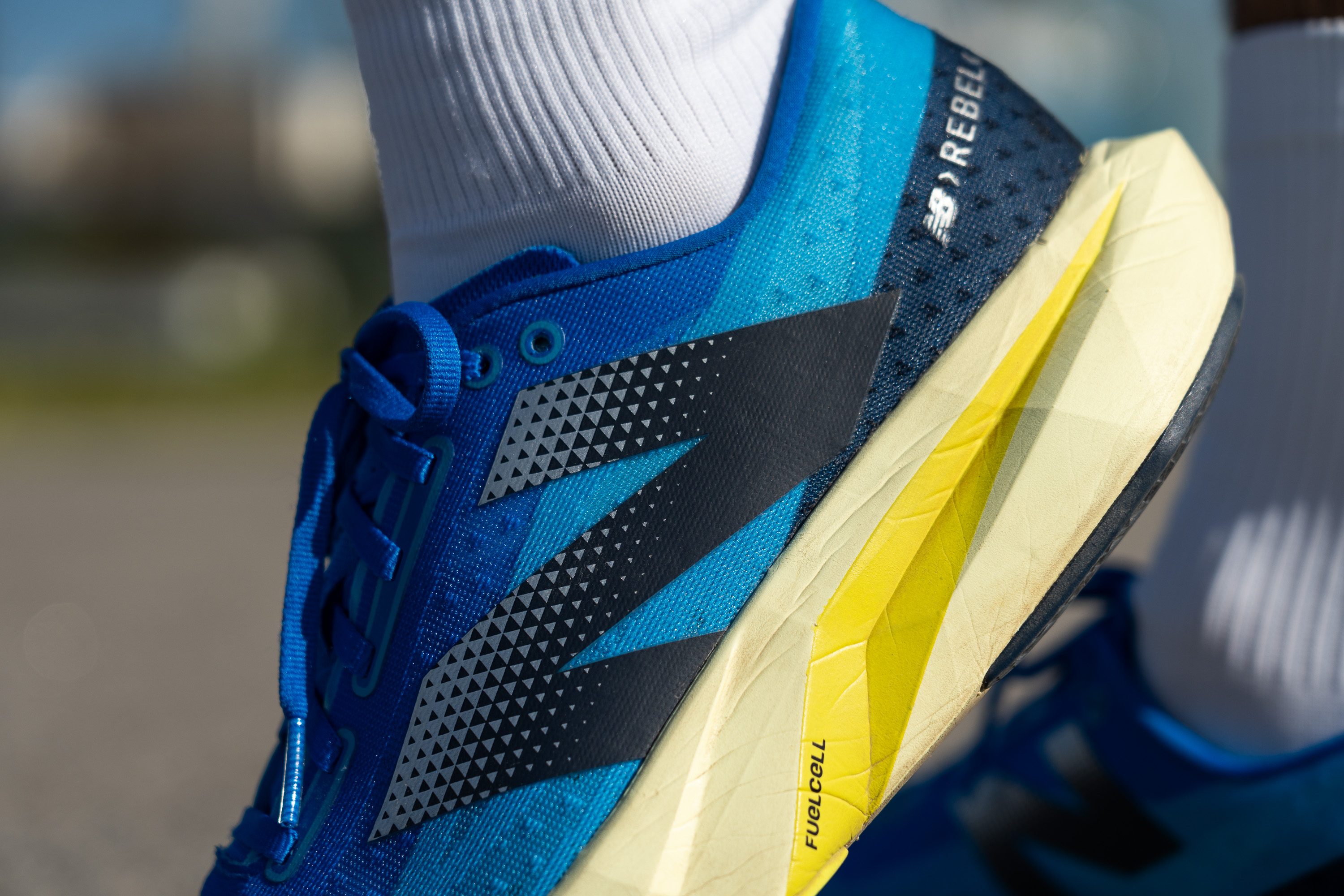
It's clear there are two approaches to achieving good durability while keeping the weight low, and New Balance opted for the strategy of using thicker rubber, rather than a thinner layer that covers more of the midsole.

| FuelCell Rebel v4 | 3.2 mm |
| Average | 3.2 mm |
Misc
Insole thickness
The insole, reminiscent of those found in racing shoes, measures just 2.5 mm.
We particularly appreciate this thin footbed because it keeps the shoe low-profile, maximizing the foam over the insole to enhance energy return.
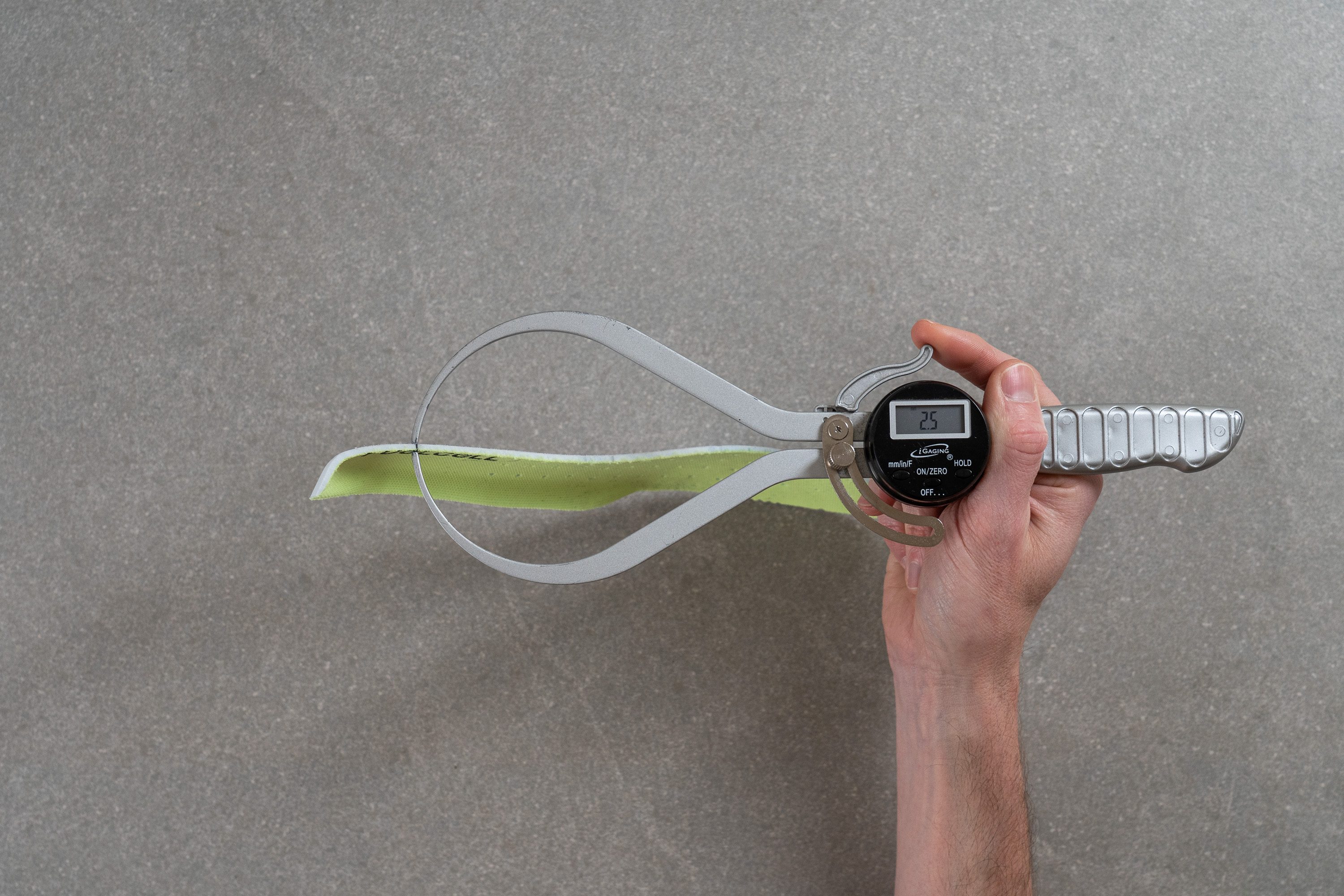
| FuelCell Rebel v4 | 2.5 mm |
| Average | 4.5 mm |
Removable insole
The insole is removable, as it isn't glued to the last—however, we advise caution when replacing it with another footbed. We discovered that the shoe is designed for a super-thin insole, and using a thicker option may overly restrict the internal vertical space.
We also found that the insole is perforated, which is a delightful addon.
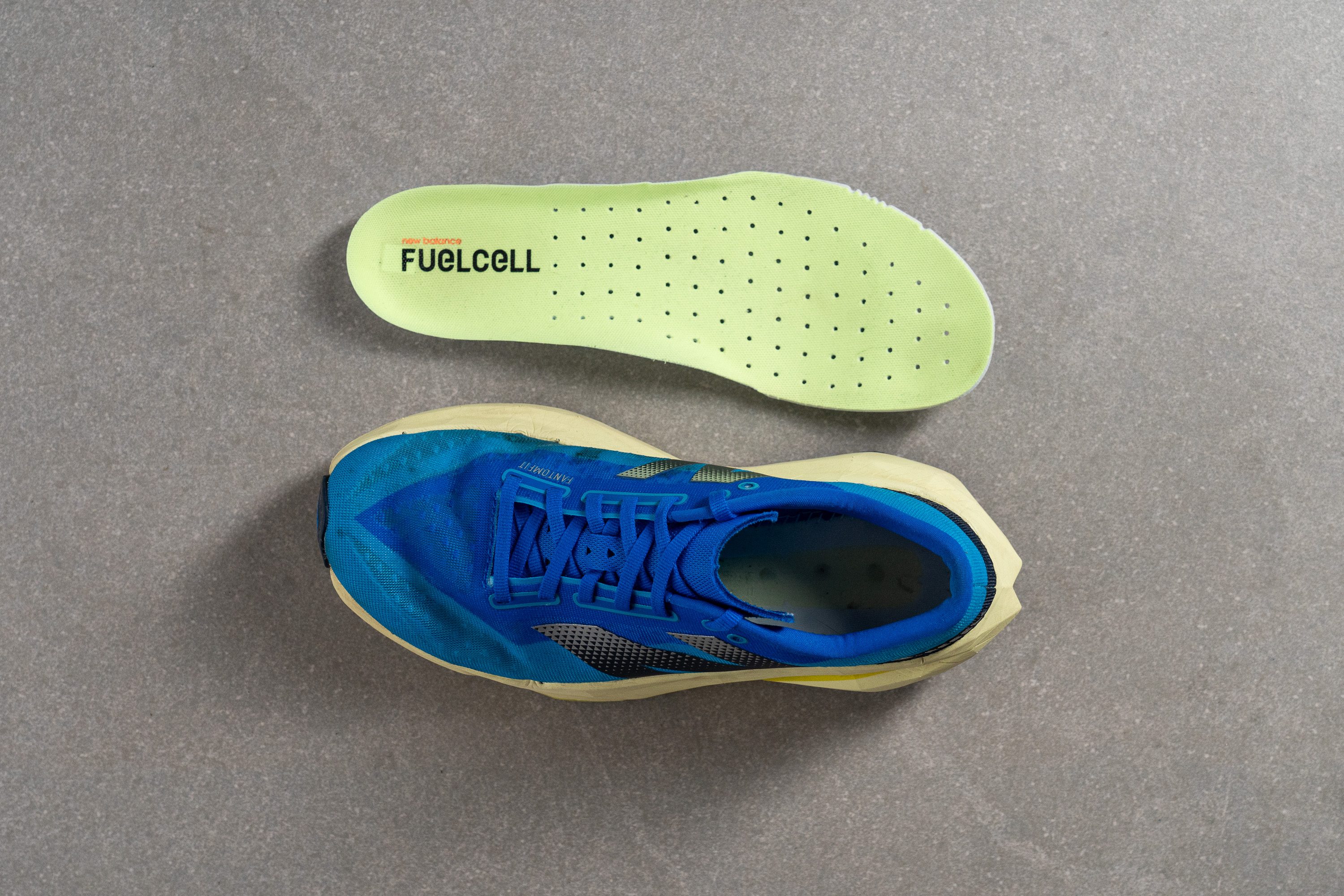
| FuelCell Rebel v4 | Yes |
Midsole softness in cold (%)
After placing the Rebel v4 in the freezer for 20 minutes and retesting it with the Shore A durometer, we discovered it became 47.1% firmer.
While that might sound significant, because the FuelCell foam is originally buttery-soft, it still measures just 12.5 HA. Consequently, the increase in firmness is not very noticeable.

| FuelCell Rebel v4 | 47% |
| Average | 24% |
Reflective elements
We love reflective elements as they enhance safety during after-dusk runs. And we found that including them in a $140 shoe is a fantastic addition—especially since the Rebel v3 featured them as well.
| FuelCell Rebel v4 | Yes |
Tongue padding
In our previous lab review, we highlighted the remarkably low weight of the Rebel v4, though it does involve some trade-offs.

One such compromise is the tongue thickness—measuring just 2.1mm, it's more akin to what you'd find on a competition shoe than on a daily trainer. Nevertheless, we've found it comfortable enough for both short and medium-distance runs, but pairing the Rebel v4 with thick, padded socks for longer runs is a must.

| FuelCell Rebel v4 | 2.1 mm |
| Average | 5.8 mm |
Tongue: gusset type
The tongue is semi-gusseted, meaning it's partially attached to the sides. We believe this is the optimal design for any running shoe aiming for speed, as it enhances the lockdown by preventing the tongue from moving sideways.
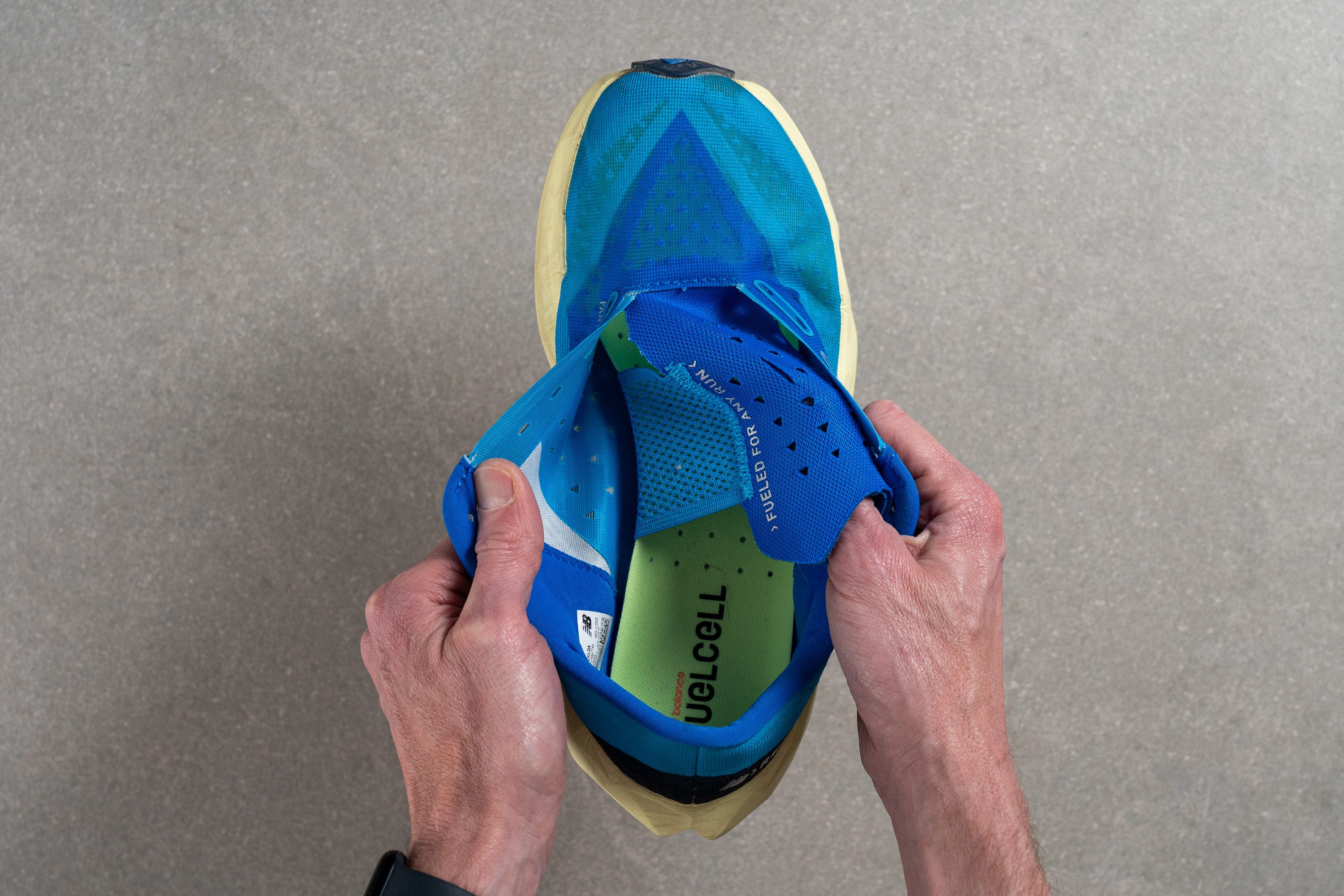
| FuelCell Rebel v4 | Both sides (semi) |
Heel tab
The Rebel v3 doesn't feature a heel tab, staying true to the simple, geometric design themes seen in the latest 2024 New Balance launches. In fact, this shoe just looks like a baby Elite v4.

| FuelCell Rebel v4 | None |

